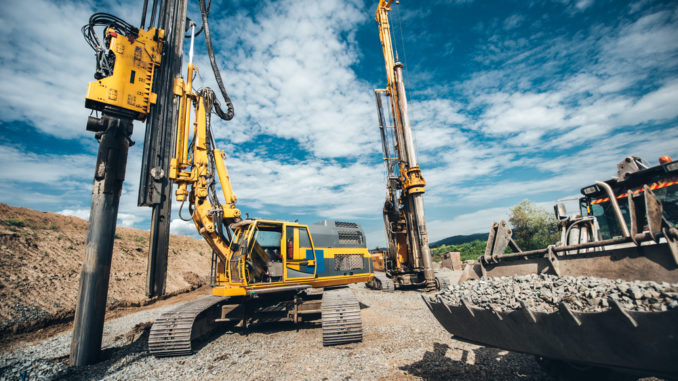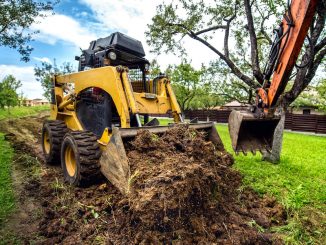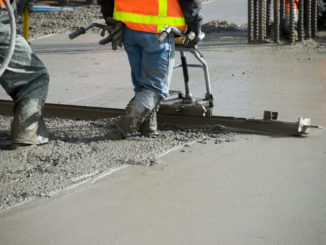
View the complete article here.
Construction materials for highway embankments, sub-grades, fills, and sub-bases always have a natural origin coming from the earth. These construction materials result from natural geological processes. It isn’t common to use synthetic materials that are produced from processes such as fly ash or slag. For this article, we are going to highlight the earth materials and how they can be used for highway projects.
Two Types of Earth Materials
There are two main types of earth materials:
- Rock: AASHTA M 146 has a definition of rock: “natural solid mineral matter occurring in large masses or fragments.” Unlike soil that is loose and unformed, rock is hardened soil that has been cemented into a form through a process known as lithification that occurs over time.
- Soil: Defined by AASHTO M 146 as “sediments or other unconsolidated accumulations of solid particles produced by the physical and chemical disintegration of rocks, and which may or may not contain organic matter.” These unconsolidated materials are used as the overlying bedrock for the project. It is natural, loose material without a form of being cemented or hardened into a form. Since it is in a loose condition, it is easy to excavate the materials using construction equipment.
Multiple construction methods can be used to process rock and soil into aggregates: crushing, blasting, washing, excavating, dredging, and screening. When the composition of the grains or fragments has not been altered, then it is considered a natural material. These natural aggregates are commonly used for highways and other construction projects.
Composition and Classification of Soil
Specific components make up soil composition, including sand, gravel, boulders, clay, silt, and colloids. These names indicate the size of the grain, not the mineral or chemical composition. Additionally, organic material is found in soil, made up of plant matter in various states of decay.
Various components affect the classification of soil, including texture, liquid limit, and plasticity. These classifications can also be used based on the percentage of organic matter found within the soil.
These field classifications are usually completed by Consultant Geotechnical companies or The Office of Geotechnical Engineering. Soil boring logs need to accompany plan sheets and contract proposals, including important information about potential material problems and soil types. Classification is determined by a basic field test and visual inspection, using these descriptions (in the specific order):
- Color: Hues of the soil when it is wet, often using the Munsell Soil Color Chart.
- Moisture: A description that includes five subcategories including dry, slightly moist, moist, very moist, and wet.
- Consistency: With six subcategories including hard, very stiff, stiff, medium stiff, soft, and very soft. Density is also described with five subcategories including very dense, dense, medium dense, loose, and very loose.
- Texture: An estimate of the amounts of clay, silt, sand, and gravel. Then, the material is classified based on Section 903. Specific texture testing details are listed below.
- Modifying Terms: Used to indicate if there are components that don’t fall in the range of textural classifications. Textural terms are commonly used: trace amounts, little, some, and. General terms include old lake bed, till, marl, peat, apparently natural ground, and fill material.
Determinations for Soil Texture
Several field tests can be done to determine the classification for the texture of the soil, determining the distribution and relative size of the soil grains or particles. First, the tester needs to distinguish fines using these guidelines:
- Washing: Clay tends to stick to the hands when rinsed lightly with water, while silt usually washes off.
- Stick: When a piece of the soil is bitten, clay tends to stick to the teeth while silt does not stick. The presence of sand will be felt in the gritty texture on the teeth.
- Grit: It feels gritty when fine sand is rubbed between the fingers and the materials don’t stain the fingers. In comparison, clay and silt usually leave a stain and feel smooth when rubbed between the fingers.
Two methods are typically used for field tests when determining soil texture. A visual examination is completed by drying a sample of the dirt and then spreading the materials on a flat surface. The materials are then divided into the components to estimate the percentage of each based on the dry weight.
A dispersion/sedimentation test can also be done. The soil sample is placed in a glass jar with water, then the person shakes the jar and allows the materials to settle. Layers will be visible, with the coarse sand and gravel settling immediately. Fine sand settles within about a minute. Silt settles in about an hour. Clay has an indefinite suspension in the water without settling. Then, the percentage is determined based on the thickness of the settled layers.
Identifying Granular Materials
A No. 200 sieve can be used to measure granular materials, which are gravels and sand using a loosely defined classification. These guidelines are used when classifying and describing granular materials:
- First, identify the largest particle found in the sample
- If gravel is present, it should be removed and estimated
- Determine whether the sand or gravel is dirty or clean
- If appreciable fines are present, then the fines need to be classified as clay or silt using the guidelines listed above
Dirty vs. clean can be determined with two basic field tests. First, the material is placed in a jar with water. If the water clears in 30 seconds due to the settling of the sand, then it is clean. When the water remains cloudy, it is a dirty sample.
A dust formation test can be used by letting the granular materials dry out. The materials are sifted through the fingers, allowing the materials to fall on a clean, hard surface. When large amounts of clay and silt are found, then dust will result when the materials hit the surface.
Identifying Silt-Clay Materials
These materials are usually composed of grains that are so small they can’t be distinguished based on size. Field tests might include:
- Plasticity Test: Can the materials be molded within a specific moisture range? A thread/ribbon test can be done by rolling the soil with a diameter between 1/2 and 3/4 of an inch and between 3 and 5 inches in length. This formation is pressed between the index finger and thumb to create a ribbon that is 1/8 inches thick. High plasticity means that a longer ribbon can be formed before the formation breaks.
- Breaking Test: A soil sample is allowed to air dry in a formation that is about 1 1/4 inches in diameter and 1/2 inches thick. Then, the thumb and fingers are used to break the pat. If it is a highly plastic clay, then it is resistant to breakage. Low plasticity means that the clay can be broken with ease.
- Shaking Test: A pat of soil is moistened so that it has a putty texture, then put in the palm. The hand is shaken If a glistening appearance shows up on the surface, then it means that moisture is rising to the top. Moisture comes to the surface rapidly for fine sand, it is slow for silt, and it does not occur for clay.
Identifying Marl and Peat
Typically, a visual inspection is done to identify peat and marl. The test analyzes the smell, color, compressibility, and density.
- Peat: This soil is highly organic, which means that it is composed of a large percentage of plant matter that is decaying. So, it has a fibrous texture.
- Marl: In comparison, marl is composed of animal remains, usually in the form of shells.
When a soil is organic, it has a color that ranges between dull brown and black. The texture is spongy. Also, there is an odor of decay, either slight or strong depending on the sample.
Rock and Shale Embankment
INDOT has three categories that are used for shale and rock embankments:
- Rock: Including sedimentary (shale, limestone, and sandstone), igneous (basalt and granite), and metamorphic (gneiss, slate, and marble).
- Shale, Mixtures of Shale and Soft Rock, or Soft Rock: The composition of shale is a lamination of mud, silt, or clay. The hardness is variable, but the rocks have an impermeability that doesn’t allow the water to leave. So, there is a significant change in volume when water is absorbed. Construction problems might include erosion, instability of the slope, heaving, and settlement.
- Shale and Limestone Thinly Layered: When limestone and shale are mixed together, they are interbedded. It is basically a mix of rock and shale, which means that there is a potential for slaking.
Other Fill Materials and Embankments
These materials may not be aggregates, which means that they don’t need to originate from a Certified Aggregate Producer (CAP). This category might include borrow, b-borrow, and structure backfill.
Aggregate materials, originating from a Certified Aggregate Producer, include the aggregate base, subbase, and aggregate shoulders or pavements.
Synthetic materials can also be used for highway construction. These materials are waste or by-products that are processed or reclaimed. But, the use of these materials is restricted and limited: coal combustion by-products, crushed glass, and recycled concrete pavement.
View the complete article here.
What are the two main types of earth materials used in highway construction?
The two main types are rock, formed through lithification, and soil, which is loose and unformed, both derived from natural geological processes.
How is soil classified in highway construction, and what factors are considered?
Soil is classified based on color, moisture, consistency, and texture, considering factors such as density and modifying terms, with field tests including washing, stick, and grit methods for texture determination.












































